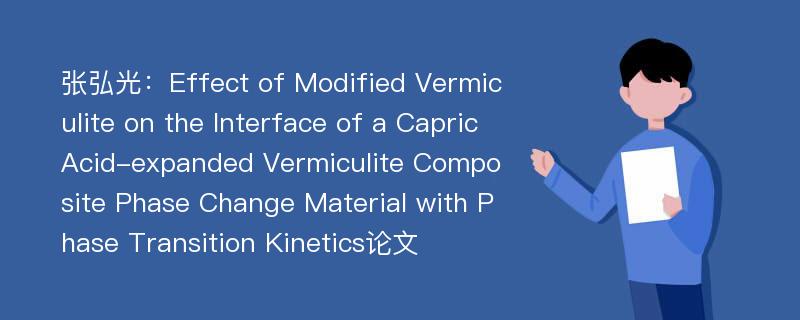
本文主要研究内容
作者张弘光,朱教群(2019)在《Effect of Modified Vermiculite on the Interface of a Capric Acid-expanded Vermiculite Composite Phase Change Material with Phase Transition Kinetics》一文中研究指出:A new type of capric acid(CA)-acid expanded vermiculite(AEV) composite phase change material(PCM) with improved adsorption ability and interface adhesive strength was developed. Through the analysis of non-isothermal phase transition kinetics, modified vermiculite was observed to change and affect the phase transformation mechanism of the composite. AEV was treated with hydrochloric acid to improve the specific surface area and micro-pore structure. The surface area measured by BET increased from 81.94 m2/g for expanded vermiculite(EV) to 544.13 m2/g for AEV. CA-EV and CA-AEV composite PCMs were prepared by direct impregnation. The non-isothermal phase transition isotherms of CA-EV and CA-AEV were recorded by DSC at different heating rates(1, 5, 10, 15, and 20 ℃/min), which indicated that the phase transition rate increased with the heating rate and the phase transition process changed. Kinetics parameters were analyzed by a double extrapolation method. The activation energy(E) under the original state(Eα→0) of CA-AEV and CA-EV was 1 117 kJ/mol and 937 kJ/mol, respectively, and 1 205 kJ/mol and 1 016 kJ/mol under the thermal equilibrium state(Eβ→0). The most probabilistic mechanism function of CA-AEV satisfied G(α)=α2/3, which followed the Mample special rule, and the function of CA-EV satisfied G(α)=[(1+α)1/3-1]2, which followed the anti-Jander function.
Abstract
A new type of capric acid(CA)-acid expanded vermiculite(AEV) composite phase change material(PCM) with improved adsorption ability and interface adhesive strength was developed. Through the analysis of non-isothermal phase transition kinetics, modified vermiculite was observed to change and affect the phase transformation mechanism of the composite. AEV was treated with hydrochloric acid to improve the specific surface area and micro-pore structure. The surface area measured by BET increased from 81.94 m2/g for expanded vermiculite(EV) to 544.13 m2/g for AEV. CA-EV and CA-AEV composite PCMs were prepared by direct impregnation. The non-isothermal phase transition isotherms of CA-EV and CA-AEV were recorded by DSC at different heating rates(1, 5, 10, 15, and 20 ℃/min), which indicated that the phase transition rate increased with the heating rate and the phase transition process changed. Kinetics parameters were analyzed by a double extrapolation method. The activation energy(E) under the original state(Eα→0) of CA-AEV and CA-EV was 1 117 kJ/mol and 937 kJ/mol, respectively, and 1 205 kJ/mol and 1 016 kJ/mol under the thermal equilibrium state(Eβ→0). The most probabilistic mechanism function of CA-AEV satisfied G(α)=α2/3, which followed the Mample special rule, and the function of CA-EV satisfied G(α)=[(1+α)1/3-1]2, which followed the anti-Jander function.
论文参考文献
论文详细介绍
论文作者分别是来自Journal of Wuhan University of Technology(Materials Science)的张弘光,朱教群,发表于刊物Journal of Wuhan University of Technology(Materials Science)2019年02期论文,是一篇关于,Journal of Wuhan University of Technology(Materials Science)2019年02期论文的文章。本文可供学术参考使用,各位学者可以免费参考阅读下载,文章观点不代表本站观点,资料来自Journal of Wuhan University of Technology(Materials Science)2019年02期论文网站,若本站收录的文献无意侵犯了您的著作版权,请联系我们删除。
标签:Journal of Wuhan University of Technology(Materials Science)2019年02期论文;
